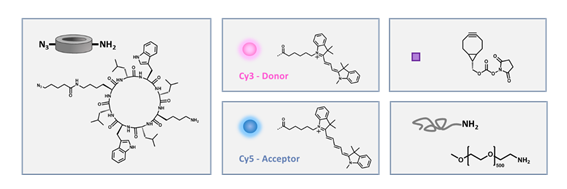Nanotubes and other nanoscale structures have proven to be very useful devices; with biomedical applications spanning from biosensors to antimicrobials and drug delivery vectors. Self-assembling cyclic peptide-polymer nanotubes in particular have desirable features thanks to their well-defined diameter, tunable peptide anatomy and ability to disassemble in situ. Understanding how these molecules behave in different environments is crucial in optimising their use, however, the underlying mechanism behind assembly and disassembly of these structures remains to be elucidated.

The basic building block of self-assembling cyclic peptide-polymer nanotubes is an alternating D- and L- amino acid chain which join to form a flat disk-like structure (fig 1). These disk like structures form hydrogen bonds with each other, resulting in tubular arrays. It is unclear whether these supramolecular structures are kinetically stable or if they exist in a kinetic equilibrium. However a better understanding will improve their use in a range of biological applications.

|
Figure 1. Shows the structure of the cyclic peptide molecules (and the various side chains added to form the different conjugates)
|
Scientists from the universities of Warwick employed a variety of methods to analyse the conformation of these structures in various environments in order to understand the limitations of their uses. Cyclic- protein (CP) polymer conjugates were synthesized with fluorescent dyes and Förster resonance energy transfer (FRET) was used to probe the dynamic nature of the stacking of the nanotubes that formed. FRET is a precise method of calculating the distance between fluorescently dyed molecules and is therefore a widely used tool in the study of biomolecules such as proteins. The use of different solvents and concentrations allowed the parameters of the nanotubes abilities to be studied, with the use of mammalian cells providing an insight into how the nanotubes react in a complex biological environment.
“This work focuses on using peptide supramolecular assembly to direct the assembly of polymers into nanotubular structures. The resulting materials have a range of applications including nonporous membranes, transmembrane channels and drug delivery vectors." Professor Sébastien Perrier, The University of Warwick/ Monash University
Small-angle neutron scattering (SANS) on the instrument SANS2D at ISIS Neutron and Muon Source was used to analyse the length and composition of the nanotubes formed, giving insight into how a mixture of conjugates effects the nanotube formation as well as to study the effect of the presence of dye molecules on the stacking of CPs compared to the non-dye controls.
“This study shows that these assemblies are dynamic, so we can 'mix and match' different peptide and polymer conjugates into one tubular structure. This means we can co-assemble various functional conjugates, for instance conjugates carrying a drug with conjugates carrying a fluorescent probe, so that we can not only deliver the drug in specific cells but also track the nanostructure." Professor Sébastien Perrier, The University of Warwick/ Monash University
Initial results show these molecules to have great potential in a variety of biological uses and with further insight into their behaviour in specific environments, could prove to be highly controllable.
Further information
The
research paper published can be
found here: J. Y. Rho, J. C. Brendel, L. R. MacFarlane, E. D. H. Mansfield, R. Peltier, S. Rogers, M. Hartlieb, S. Perrier, Adv. Funct. Mater. 2017, 1704569. https://doi.org/10.1002/adfm.201704569
See here to learn more on our instrument SANS2D.
